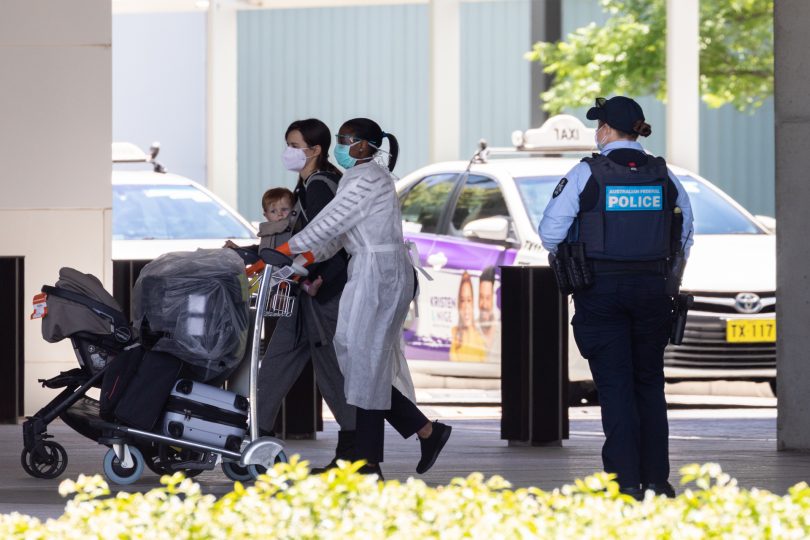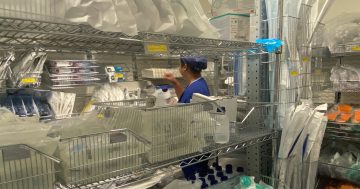
Repatriation flights are currently paused at Canberra Airport. Photo: Region Media.
Returning much of Australia to a form of how things were pre-March 2020 relies on our ability as a nation to establish a resilient and sustainable international quarantine system, supported by equally resilient and sustainable quarantine isolation facilities.
The fundamentals for international arrivals are clear and well understood. People need to be in quarantine until it can be established they are no longer able to be disease carriers. To do this, they must remain in isolation for sufficient time to either show symptoms, become sick, or remain disease free for longer than the disease incubation period.
Nationally, Australia is operating three distinct models for international arrival quarantine. The states utilise city hotels, the ACT uses apartments, and the Northern Territory uses the Howard Springs facility.
Depending on where you arrive into Australia, you either experience a completely sealed environment with all services provided – due to the lack of facilities – an apartment with a balcony and a degree of self-catering, or a miner’s camp.
All three models rely on an external health and hospital system, security, and a dedicated workforce to avoid spreading disease into the community. All three require participants to maintain their own hygiene, entertain themselves and maintain a level of social awareness to ensure their period in quarantine is as short as it needs to be.
Most importantly, they need to be close to an international class airport with the ability to take a long-haul airliner. These dependencies require facilities to be near a population centre, yet separate enough to ensure the requirements of quarantine can be maintained.
However, none of the systems can be considered as particularly sustainable for the long-term – and the problem is a long-term one.
Australia has been fortunate to have avoided a serious international pandemic for many years. SARS (2003), Ebola (2014-2016 and 2018-now) and MERS (2012-now) have remained predominantly offshore due to international controls and the nature of the diseases.
COVID-19 has shown us that a disease with a longer incubation period and the ability to stay viable in an asymptomatic host may require a new approach and potentially a permanent capability to provide quarantine for unlucky travellers.
So what does an ideal facility look like? It has living facilities where a traveller can self-cater, do laundry, and step outside for exercise and air without breaking quarantine. It needs staff to provide goods and services, maintain the facility and clean between guests. It needs to cope with the needs of a lone business traveller, a family, or a sports team.
It needs to be secure, but not take the immediate appearance of a prison. It also needs the ability to surge, yet the ability to be put into hiatus as needs fluctuate.
In some ways, the ideal facility is a bit like going to a desert or island resort. The current Howard Springs facility is a version of a caravan park with lots of cabins and a few more fences.
To staff out facilities of the future, we will need to progress past drawing heavily on health systems and emergency services to deliver a range of services besides existing hospitality workers.
A new model will require a new era of hospitality worker. The new worker will be fully conversant in personal protective equipment (PPE) and infection control, and be able to provide hospitality and management services and run a hospitality facility that is dealing with predominantly healthy clientele who is pausing in a facility before continuing with their business or holiday.
Health departments will provide the medical oversight, and police will ensure compliance with the law.
The challenge to establishing this new era of quarantine will be ensuring the model can be as cost effective as possible, while being as pleasant as possible for guests.
In time, travellers may have to accept that a trip to or from Australia may require a three-to-four day transit through a purpose-built facility where the cost is borne by the traveller. The costs per guest/family has already been established through the existing programs so we have a target for creating a sustainable proposition.
Who will lead the thinking and establishment of the quarantine facilities into the future? The current situation demonstrates that while government can set the performance requirements, it is probably up to the private sector to identify a working solution and then work with government to fund, support and underwrite the initial operation for the good of the nation.
Matthew Harper is the managing director of Resilient Results. He has worked for more than 30 years in emergency and crisis management in governments and the private sector.
Original Article published by Matthew Harper on The RiotACT.








